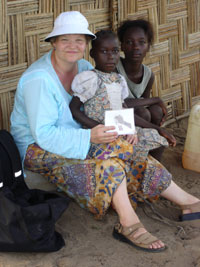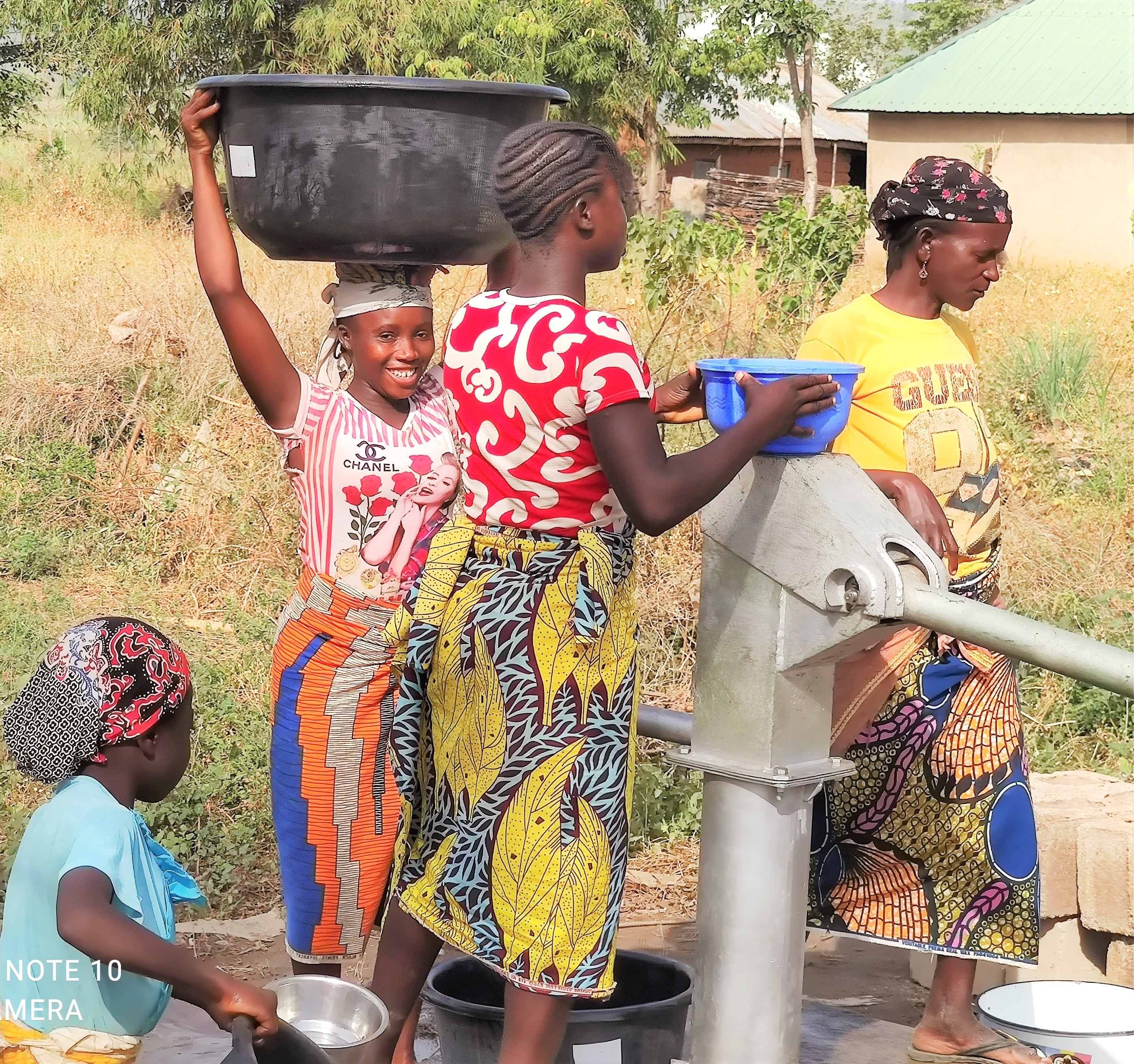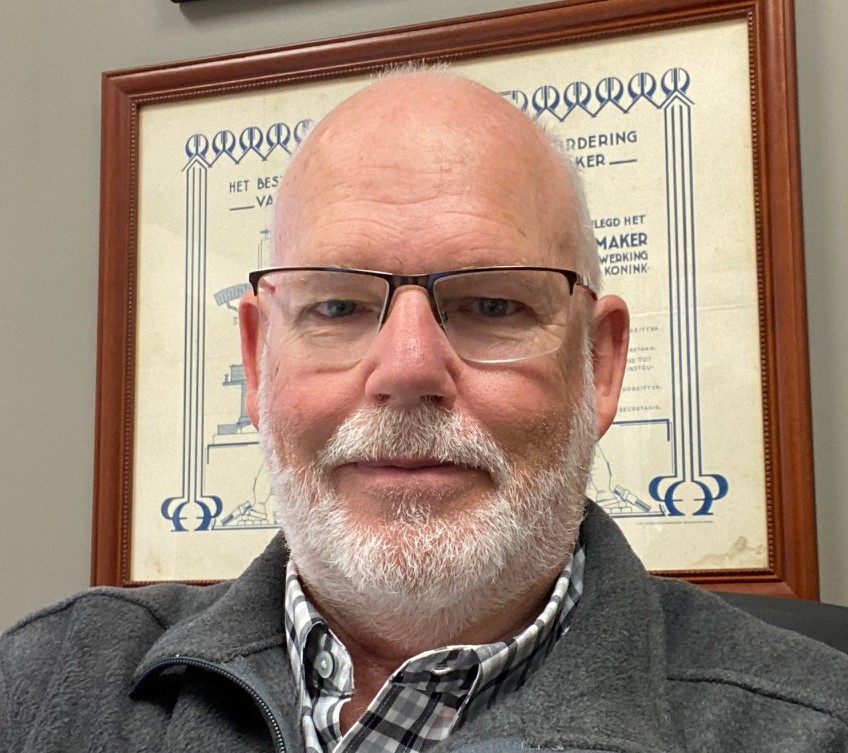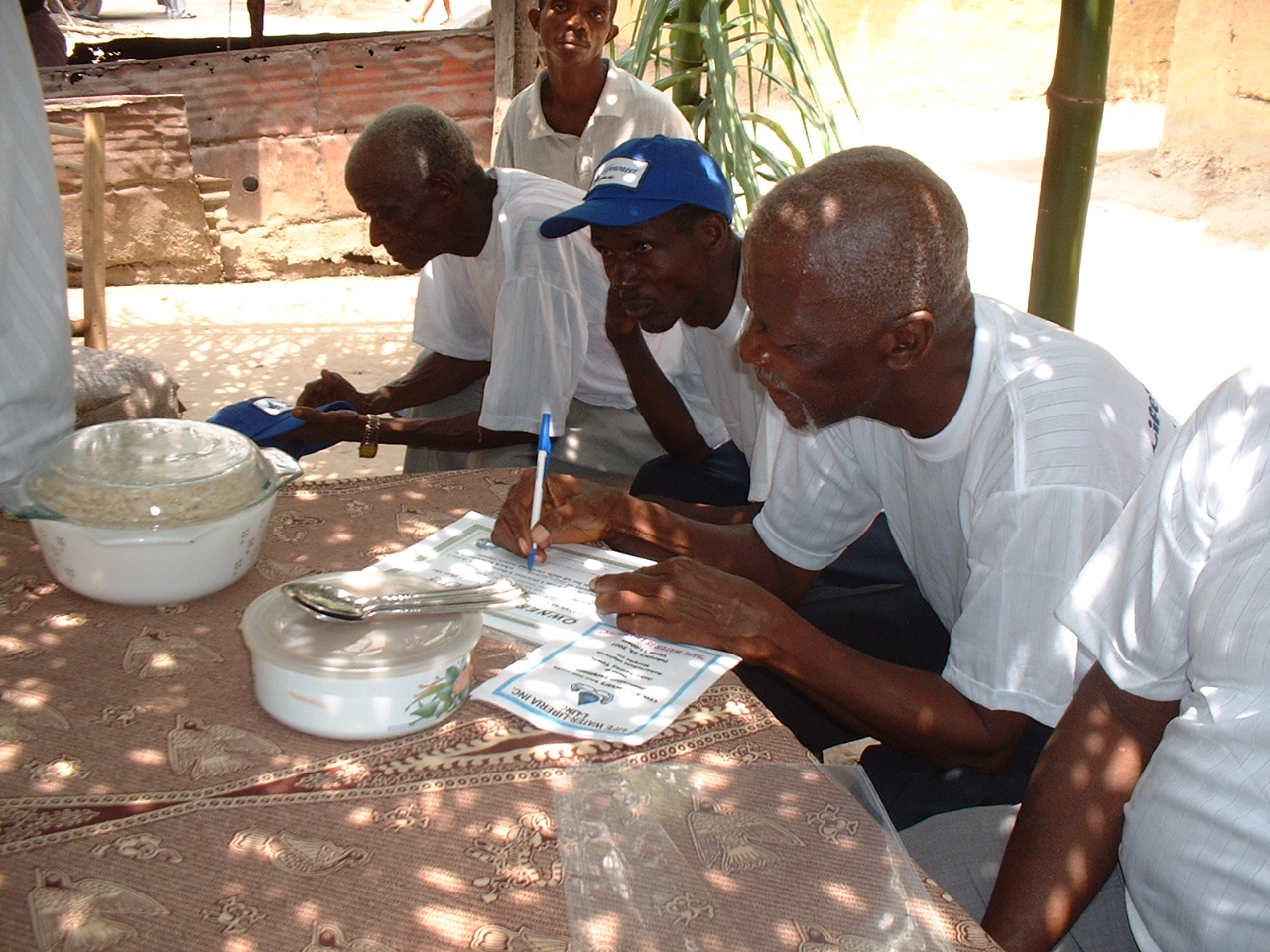⭠ back to development goals
DEVELOPMENT GOAL #3:
Actively Engage Communities
Rationale: A water project must not be built in a location where it won't be well used, or where it inadvertently increases religious or inter-tribal conflict over power or control.
TARGET 1: Health and Hygiene training with all water projects
| 4 Points |
In 2004, Lifewater introduced Health and Hygiene workshops as part of its well drilling program. The goal is to have these training workshops happen upfront, as part of the community mobilization effort. Empowerment through knowledge leads to immediate health benefits and motivates beneficiaries to actively contribute to planned water projects.
This training provides direct and immediate health benefits by covering topics such as "What is disease?", "How is Disease Transmitted?", "How do you break Disease Transmission Pathways?", and "What do you do with young children who have Running Stomach"? Ultimately, different water-related diseases all have the same symptom: diarrhea (or "running stomach") that causes rapid dehydration and can lead to death.
Education is important for ongoing well maintenance. If people see clean water as being vital to the health, they will be willing to occasionally spend a little time and money to keep their water supply safe and functioning reliably.
Application Story: Spoonful of Death
In 2007, Lynda Gehrels (now Lifewater Canada's president) used her 35 years experience as a Registered Nurse to help prepare Health and Hygiene lessons to share during her first trip to Liberia. She wasn't however, prepared for what would transpire in the middle of her class.
Twenty-five men and women, with several toddlers and a few babies wrapped around their mom's bodies, attended the long training sessions over the course of three days. The information was simple in concept and was offered through skits, stories and photos — with constant individual participation required. It was hands-on training, and by the end of the second day, people were getting pretty comfortable with each other.
"I was sharing how unsafe drinking water was the reason why so many suffered from running stomach (diarrhea), with the wee ones and the elderly especially prone to get ill and often die," Lynda recalls. "It was a lesson I had covered many times before, but this time I noticed one of the older women in the class start to silently cry, tears running down her cheeks."
"Later, I shared a taxi home with her daughter-in-law. Her own tears started to fall as she explained that in the class, her mother-in-law had realized that the family tradition to give every one-month-old baby their first drink of water from the local watering hole had directly led to the death of two of her grandchildren. They had spoken together after the class and she had found the strength and faith to forgive her mother-in-law. My tears were the only consolation I could offer as I listened to the grief and pain in her words," explained Lynda.
 "My second trip to Liberia painted a bright rainbow around that painful memory. I met with these same women and they were so happy to share their success story. While visiting a relative, a child had gotten very ill with diarrhea, and the village was too far from a clinic to seek help. They were able to use the information they'd learned in our workshop and the child regained his strength and lived," Lynda recalls.
"My second trip to Liberia painted a bright rainbow around that painful memory. I met with these same women and they were so happy to share their success story. While visiting a relative, a child had gotten very ill with diarrhea, and the village was too far from a clinic to seek help. They were able to use the information they'd learned in our workshop and the child regained his strength and lived," Lynda recalls.
"Although it didn't dim their grief, it offered some balancing joy that this life would be spared to grow and bloom! That's pretty great fruit from a simple hygiene lesson!"
TARGET 2: Community involved in picking well site
| 2 Points |
Wells need to be located in a place that balances technical factors along with social and cultural considerations. To learn more about these factors, see Lifewater Well Drilling Manual Section 2 "Deciding Where to Drill"
Application Story: Too Many Men

The well location was changed to be near a big tree just out of sight of the village huts, so the women did not have to walk far, but could still have their time to relate together in private.
Application Story: The Lions will Eat You
 An even more memorable story about the importance of community involvement in determining where a well will be drilled comes from Kenya. Lifewater Canada's Harry Oussoren was there to help villagers who had to walk very far for safe drinking water.
An even more memorable story about the importance of community involvement in determining where a well will be drilled comes from Kenya. Lifewater Canada's Harry Oussoren was there to help villagers who had to walk very far for safe drinking water.
With a generous donor funding his work, Harry rented a big rig and tried drilling where the community wanted him to — at the top of a big hill, close to their homes. Despite long hours of drilling to great depth, the borehole was dry. They tried drilling another hole nearby but it also was dry. Their third attempt was also unsuccessful.
Harry was reaching the end of his patience and reasoned with the community members that the next attempt should be at the bottom of the hill, as the big trees there signaled the presence of water. The community leaders said the well could not go there.
Harry then tried to explain some hydrogeology. He talked about aquifers and that at the bottom of the hill, they would not have to drill as deep to find the water table. Again, the community leaders said the well could not go there.
Harry tried one more time — finally raising the issue of his depleted budget and how the most likely place to find water would still be at the bottom of the hill. Again the leaders said the well could not go there.
Finally Harry lost his temper and demanded: "Why can't the well go there?!" The chiefs responded saying, "Because the lions who live there will eat you."
Together, they found a better location for the well.
TARGET 3: Community participation (financial, labour, etc.)
| 2 Points |
Lifewater is mindful of the United Nation's "Agenda 2030" (The 2030 Sustainable Development Agenda and its Sustainable Development Goals) which set out a universal framework for action and global goals that are based on sustainable development principles. Target 6.b calls on development agencies to "Support and strengthen the participation of local communities in improving water and sanitation management."
Lifewater has done this for years and, as discussed below, we have learned that this is a critical part of successful long-term project maintenance. It is emotionally difficult to require a community to contribute when they have so little. But contribution of effort, materials and cash money creates the sense of ownership needed for long-term project maintenance. Further discussion on this can be found in our Well Drilling Manual.
Application Story: "Your Well is Broken"
From 1995 to 2004, Liberia was caught in a bloody civil war. During this time, wells were gifts, fully funded by Canadian donors. Villages did not have to contribute to the new project.
In 2004, the war was over and a team of volunteers was helping drill a well along the Robertsfield Highway. Nothing went right, and it was a long, frustrating process.
To end the week on a positive note, the team decided to visit a village where a well had been drilled two years earlier. They envisioned being greeted by happy parents, playing children, and safe water flowing from the well. When the team arrived however, the pump was draped with drying laundry and the pad was parch dry. The chief greeted the team with a scowl, and angrily asked "Where have you been? Your pump has been spoiled for many months now and our children are getting sick from drinking the swamp water again!"
The team watched as women returned with coloured water from the stagnant swamp. But they also saw fish for sale at roadside stalls and new soccer nets on the community play field. Clearly, there was a disconnect between spending priorities and health impact.
Further discussion revealed that the villagers believed the pump belonged to Lifewater, not to them. They had no sense of ownership and felt like it was not their property. This was a watershed moment for Lifewater as the team realized that if they covered the entire cost of fixing the pump, it would be used until it broke and then sit until they came again. This was emergency relief rather than sustainable development.

When the chief came back, he said the plan was "no good." Instead, the town would have the money saved in only one month and they wanted the repair team to come back then.
When we came back and repaired the pump, the chief asked if his town could pay $20 in advance so when the pump broke again, the team could bring parts and fix it right away! This led to the start of a "pump insurance" program in Liberia that enables communities to pay an annual flat fee so Lifewater workers will quickly repair a well whenever it breaks.
TARGET 4: Facilities built on community land
| 1 Point |
In rural Kenya and Liberia, there were no problems with the communal nature of wells. Communities are based on social circles of support and the water clearly benefits everyone and is shared by all.
But in more urban environments in Liberia and parts of Haiti, disputes sometimes developed over well ownership. Some wells were even "expropriated" and became private water supplies. Water was made available at the whim of the land owner, sometimes even at a price.
As a result, Lifewater teams now require assurance from community leaders, with affirmation from local residents, that the land is community land and that the well will remain communal.
Application Story: The Disappearing Pump
In parts of northern Haiti, development can be dense and very little land is available on which to drill a well. Following the devastating earthquake in 2000, there was limited community consultation and Lifewater teams gladly drilled wells on whatever land was offered.
In 2004, volunteers auditing wells in Haiti had a problem. One of the wells that had been drilled several years earlier had disappeared! First the team thought that maybe the pump had been stolen so they looked through tall grass for the borehole and pad. The GPS coordinates told them they were in the right area, but there was no sign of the well.
Then a gate in the wall of the adjacent private home opened, and the team could see their missing well! It hadn't moved. But after the well was originally drilled, a landowner built a security wall around his property — which included where the well was. The well effectively "vanished" as a source of communal water for surrounding residents. The landowner was a powerful political figure, and no one dared protest to him or to complain to Lifewater.
After discussions with Lifewater, the landowner agreed to have his watchman keep the gate open for two hours in the morning and two hours in the afternoon for surrounding residents to come and draw water.
This taught us the importance of spending time and effort to be assured that land on which we drill is communal land, with a small parcel being severed off for this purpose if necessary. Since then, no further problems like this have arisen.
TARGET 5: Dedication Celebration and Deed Transfer
| 1 Point |
When we buy a house in Canada, we receive a property deed. When we buy a car, we receive a title and a bill of sale. These legal documents assign us as owners of the specified property, and help instill in us a sense of ownership and responsibility for its upkeep. In the same way, the teams in Kenya and Liberia have been having "well dedication" parties since the very first wells were drilled in the 1990's.
Since 2009, the team in Liberia has been issuing "Pump Deeds", which have been presented to village chiefs at well dedications to clarify to all that the pump now belongs to the community. The back side of the deed lists tasks for the village Pump Repair Technicians and Well Caretakers to do on a daily, monthly and annual basis.
Application Story: The Widow's Well
By 2005, Lifewater had learned the importance of local communities truly "owning" a well and hand pump. We stopped putting sponsor names or dedications on wells which unintentionally identified those names as the well owners. It was part of the deliberate effort to ensure communities invested in, and were committed to, long-term project maintenance.
Earlier that year, two elderly widows decided to sponsor a well in memory of their beloved husbands. They sent in the sponsorship funds, and then went one step further by wanting to go to Kenya to see the well and participate in its dedication.
The well was drilled, the women flew to Kenya and were thrilled to see the well and meet the people who were receiving the safe drinking water. As part of the well dedication ceremony, they produced large framed photos of their husbands, told the villagers about them, and then placed a memorial plaque beside the pump.
A few months later, Lifewater received a panicked phone call from the women. They had received a long-distance phone call from the villagers, informing them that "their husbands' pump" was broken, and could they please come back to Kenya to fix it!
Our Kenya team helped fix the pump, but it took years for the villagers to adjust their thinking from the well being owned by those white-haired Canadians to the well being their own. Even after the widows died, the villagers still did not consider the pump as their own. It was only when a "Deed of Pump Ownership Transfer" with official stamps and seals was made and delivered to the village chief did they finally take responsibility for maintaining the pump!

